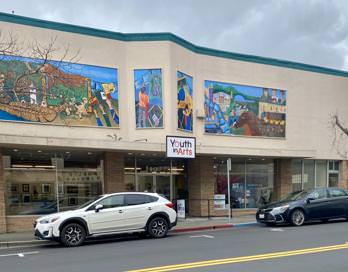Mr. B (James Franco) lays an awkward hand on April’s elbow and gives it a slight rub before walking away, smiling carnivorously to himself. The camera zooms in tight on April (Emma Roberts) as she displays a more nervous look, suggesting she already lost the confidence she found in the cigarette she smoked just before practice.
Palo Alto is an indie visual adaptation of Franco’s book Palo Alto Stories, a collection of fictional stories based off of his memories of attending high school in Palo Alto.
Though Franco is the author of the book, director Gia Coppola wrote the movie’s screenplay—but, it might have been better if she just stuck with directing. The dialogue falls flat compared to the artistic visuals, but at least the actors seem real and believable. I would describe my feelings for the film as April described her day when her mother asked how it was: “Fine.”

Just before April’s encounter with her coach, the other girls on the soccer team banter with perfect, natural timing but cliché conversation—one of the many instances where it seems the acting outdoes the screenplay.
When April walks into her mother’s bedroom to greet her after soccer practice, no more than ten words are spoken before her mom asks if she’s depressed. I roll my eyes yet again—she’s supposed to be angsty, Ms. Coppola, not depressed.
In addition to the story of April and Mr. B, Palo Alto follows a second plotline as well. However, it seldom crosses with the first. The second plotline focuses on two senior boys, Teddy (Jack Kilmer) and Fred (Nat Wolff), and is vastly more complex than April’s.
Perhaps given the alternating chapters in the book, it contained more crossover between stories than the movie due to the advantage of telling the stories from different perspectives. Even though they are compelling stories, there is no element of surprise when it comes to how the characters are related. Revealing some of the characters’ relationships later in the movie would have added a layer of complexity, elevating the movie from fine to great.
In addition, a huge discrepancy between the movie and book is April’s age when she gets involved with her soccer coach, Mr. B. In the movie, this relationship is developing in the present when she’s a senior in high school, but in the book she reflects upon the experience that happened when she was 13.
The back-in-time aspect would have been too difficult to elegantly portray in the movie, but the adaptation still changes a big detail in the storyline.
The smaller cinematic details are what make Palo Alto feel authentic. After Teddy gets in trouble with the law, a simple shot of him sitting on his bed is framed by glimpses of childhood pictures around his room—his old school pictures and a candid shot of when he was seven or eight. Similarly, in a scene where Emily, who is quick to offer sexual favors to many characters, is in bed with Fred, their conversation is played over close ups of the pink and purple figurines on her shelves—the girly reminders marking her once innocent hobbies. The stark contrast in both scenes takes advantage of what the book cannot do: reveal details of the surroundings while the kids in the scene are busy.
Near the end of the movie I began to ask myself, “what was the point of that?” But perhaps the events of the film don’t come as a surprise to me because I’m living them—just 50 miles north of Palo Alto High where Franco drew his inspiration for the stories. Perhaps, it became more clear, the film is more of an artistic commentary on his Palo Alto stories, meant to reveal emotions that words cannot convey.
It ends on an unsatsifying note. However, seniors often bittersweetly leave high school with similar feelings: looking to the future and wishing they had more time.
Palo Alto isn’t meant to necessarily teach a lesson, but, rather, to poetically and honestly display the trials and tribulations of high school students. They may act rashly, make poor decisions and incite fear in each other, but they certainly don’t believe they are invincible.
Palo Alto was released in select theaters May 9, but opens for the first time in Marin at the Rafael Theater today. The film runs 100 minutes.















